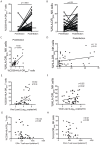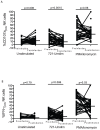Changes in Natural Killer cell activation and function during primary HIV-1 Infection
- PMID: 23326405
- PMCID: PMC3541400
- DOI: 10.1371/journal.pone.0053251
Changes in Natural Killer cell activation and function during primary HIV-1 Infection
Abstract
Background: Recent reports suggest that Natural Killer (NK) cells may modulate pathogenesis of primary HIV-1 infection. However, HIV dysregulates NK-cell responses. We dissected this bi-directional relationship to understand how HIV impacts NK-cell responses during primary HIV-1 infection.
Methodology/principal findings: Paired samples from 41 high-risk, initially HIV-uninfected CAPRISA004 participants were analysed prior to HIV acquisition, and during viraemic primary HIV-1 infection. At the time of sampling post-infection five women were seronegative, 11 women were serodiscordant, and 25 women were seropositive by HIV-1 rapid immunoassay. Flow cytometry was used to measure NK and T-cell activation, NK-cell receptor expression, cytotoxic and cytokine-secretory functions, and trafficking marker expression (CCR7, α(4)β(7)). Non-parametric statistical tests were used. Both NK cells and T-cells were significantly activated following HIV acquisition (p = 0.03 and p<0.0001, respectively), but correlation between NK-cell and T-cell activation was uncoupled following infection (pre-infection r = 0.68;p<0.0001; post-infection, during primary infection r = 0.074;p = 0.09). Nonetheless, during primary infection NK-cell and T-cell activation correlated with HIV viral load (r = 0.32'p = 0.04 and r = 0.35;p = 0.02, respectively). The frequency of Killer Immunoglobulin-like Receptor-expressing (KIR(pos)) NK cells increased following HIV acquisition (p = 0.006), and KIR(pos) NK cells were less activated than KIR(neg) NK cells amongst individuals sampled while seronegative or serodiscordant (p = 0.001;p<0.0001 respectively). During HIV-1 infection, cytotoxic NK cell responses evaluated after IL-2 stimulation alone, or after co-culture with 721 cells, were impaired (p = 0.006 and p = 0.002, respectively). However, NK-cell IFN-y secretory function was not significantly altered. The frequency of CCR7+ NK cells was elevated during primary infection, particularly at early time-points (p<0.0001).
Conclusions/significance: Analyses of immune cells before and after HIV infection revealed an increase in both NK-cell activation and KIR expression, but reduced cytotoxicity during acute infection. The increase in frequency of NK cells able to traffic to lymph nodes following HIV infection suggests that these cells may play a role in events in secondary lymphoid tissue.
Conflict of interest statement
Figures




Similar articles
-
HLA-C levels impact natural killer cell subset distribution and function.Hum Immunol. 2016 Dec;77(12):1147-1153. doi: 10.1016/j.humimm.2016.08.004. Epub 2016 Aug 10. Hum Immunol. 2016. PMID: 27521484 Free PMC article.
-
Alterations in natural killer cell receptor profiles during HIV type 1 disease progression among chronically infected South African adults.AIDS Res Hum Retroviruses. 2010 Apr;26(4):459-69. doi: 10.1089/aid.2009.0176. AIDS Res Hum Retroviruses. 2010. PMID: 20380481 Free PMC article.
-
HIV exposed seronegative (HESN) compared to HIV infected individuals have higher frequencies of telomeric Killer Immunoglobulin-like Receptor (KIR) B motifs; Contribution of KIR B motif encoded genes to NK cell responsiveness.PLoS One. 2017 Sep 22;12(9):e0185160. doi: 10.1371/journal.pone.0185160. eCollection 2017. PLoS One. 2017. PMID: 28938026 Free PMC article.
-
Natural killer cell heterogeneity: cellular dysfunction and significance in HIV-1 immuno-pathogenesis.Cell Mol Life Sci. 2015 Aug;72(16):3037-49. doi: 10.1007/s00018-015-1911-5. Epub 2015 May 5. Cell Mol Life Sci. 2015. PMID: 25939268 Free PMC article. Review.
-
The role of NK cells in HIV-1 protection: autologous, allogeneic or both?AIDS Res Ther. 2016 Mar 18;13:15. doi: 10.1186/s12981-016-0099-6. eCollection 2016. AIDS Res Ther. 2016. PMID: 26997965 Free PMC article. Review.
Cited by
-
Mucosal-homing natural killer cells are associated with aging in persons living with HIV.Cell Rep Med. 2022 Oct 18;3(10):100773. doi: 10.1016/j.xcrm.2022.100773. Epub 2022 Oct 7. Cell Rep Med. 2022. PMID: 36208628 Free PMC article.
-
Clinical and experimental treatment of residual immune activation in people living with HIV.Clin Exp Immunol. 2025 Jan 21;219(1):uxaf023. doi: 10.1093/cei/uxaf023. Clin Exp Immunol. 2025. PMID: 40243265 Review.
-
Human Hematopoietic Stem Cell Engrafted IL-15 Transgenic NSG Mice Support Robust NK Cell Responses and Sustained HIV-1 Infection.Viruses. 2023 Jan 27;15(2):365. doi: 10.3390/v15020365. Viruses. 2023. PMID: 36851579 Free PMC article.
-
The New Kid on the Block: HLA-C, a Key Regulator of Natural Killer Cells in Viral Immunity.Cells. 2021 Nov 10;10(11):3108. doi: 10.3390/cells10113108. Cells. 2021. PMID: 34831331 Free PMC article. Review.
-
Elevated levels of invariant natural killer T-cell and natural killer cell activation correlate with disease progression in HIV-1 and HIV-2 infections.AIDS. 2016 Jul 17;30(11):1713-22. doi: 10.1097/QAD.0000000000001147. AIDS. 2016. PMID: 27163705 Free PMC article.
References
-
- Giorgi JV, Ho HN, Hirji K, Chou CC, Hultin LE, et al. (1994) CD8+ lymphocyte activation at human immunodeficiency virus type 1 seroconversion: development of HLA-DR+ CD38− CD8+ cells is associated with subsequent stable CD4+ cell levels. The Multicenter AIDS Cohort Study Group. The Journal of infectious diseases 170: 775–781. - PubMed
Publication types
MeSH terms
Substances
Grants and funding
LinkOut - more resources
Full Text Sources
Other Literature Sources
Medical

